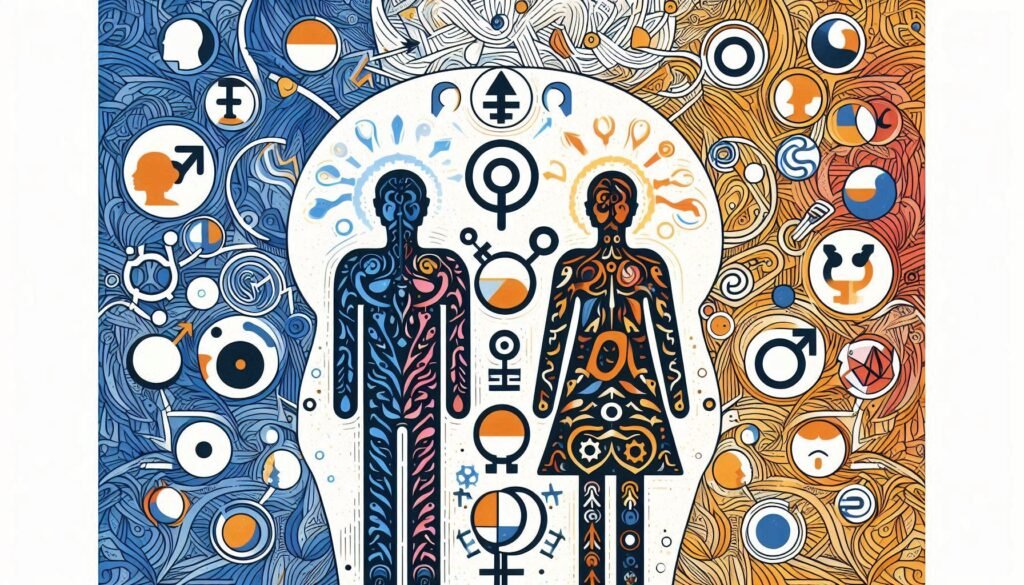Personality disorders can profoundly affect an individual’s life, shaping how they perceive themselves and interact with the world. Yet, when we delve into this complex topic, one important aspect often emerges: gender differences in personality disorders. Research indicates that men and women may exhibit distinct patterns of behavior, symptoms, and diagnoses related to these disorders. Understanding these variations is crucial not only for accurate assessment but also for effective treatment strategies.
This blog explores the intricate connection between gender and personality disorders. From historical perspectives to biological influences and sociocultural factors, we’ll uncover the nuances that shape how different genders experience these mental health challenges. Join us as we navigate through essential insights about gender differences in personality disorders—insights that could lead to better understanding and improved care for those affected.

Understanding Personality Disorders: A Brief Overview
Personality disorders are a category of mental health conditions characterized by enduring patterns of behavior, cognition, and inner experience. These patterns deviate significantly from societal expectations and can lead to distress or impairment in various aspects of life.
Typically classified into three clusters—A, B, and C—these disorders encompass a range of symptoms. Cluster A includes odd or eccentric behaviors, while Cluster B is marked by dramatic or emotional traits. Cluster C features anxious or fearful tendencies.
Diagnosis often involves careful assessment using established criteria from manuals like the DSM-5. Mental health professionals consider how these personality traits manifest across different situations and relationships. Understanding these intricacies lays the groundwork for exploring gender differences that influence diagnosis and treatment outcomes in personality disorders.
Historical Perspectives on Gender and Personality Disorders
Throughout history, the understanding of personality disorders has been deeply intertwined with gender perceptions. In earlier psychological frameworks, women were often pathologized for behaviors that diverged from traditional roles.
The medical community frequently labeled women exhibiting assertiveness or independence as hysterical. This diagnosis reflected societal discomfort rather than genuine pathological conditions. Men, conversely, faced different expectations; aggression and dominance were sometimes viewed as normative traits.
In the mid-20th century, feminist movements began challenging these biased views. Researchers started to acknowledge how gendered experiences shape mental health outcomes. However, even today, stereotypes influence diagnoses and treatment approaches.
Contemporary perspectives strive to recognize these historical biases while promoting a more nuanced understanding of personality disorders across genders. Recognizing this context is crucial in fostering fair assessment and treatment practices for all individuals affected by personality disorders.
Prevalence Rates: Comparing Personality Disorders Across Genders
Research highlights notable differences in the prevalence rates of personality disorders between genders. Studies indicate that men are more frequently diagnosed with certain Cluster A disorders, such as paranoid and schizoid personality disorders. This trend may be linked to societal expectations around masculinity.
On the other hand, women tend to exhibit higher rates of Cluster B disorders, including borderline and histrionic personality disorders. These conditions often reflect emotional dysregulation and interpersonal challenges commonly attributed to female stereotypes.
Cluster C disorders like avoidant and dependent personality disorder also show a gender disparity but are less pronounced than those found in Clusters A and B. Women are generally overrepresented here as well.
These variations raise critical questions about how diagnosis is influenced by both biological predispositions and cultural norms surrounding gender roles. Understanding these prevalence trends is crucial for accurate assessment and effective treatment strategies tailored to each gender’s unique experiences.
Biological Factors Influencing Gender Differences in Personality Disorders
Biological factors play a significant role in shaping gender differences in personality disorders. Hormonal variations between males and females can influence emotional regulation, stress response, and even behaviors associated with certain personality traits.
For instance, fluctuations in estrogen and testosterone levels may impact mood stability and impulsivity. These hormonal differences could lead to varied presentations of disorders across genders.
Genetic predispositions also contribute. Research indicates that certain genetic markers linked to anxiety or aggression might manifest differently based on one’s sex. This biological interplay creates a complex landscape for understanding the nuances of personality disorders.
Additionally, brain structure and function reveal disparities between genders. Neuroimaging studies suggest that areas responsible for emotional processing may operate distinctively in men compared to women, affecting how symptoms are expressed or perceived.
These biological underpinnings provide valuable insights into why individuals experience personality disorders differently based on their gender.
Sociocultural Influences on Gender-Specific Personality Disorder Development
Sociocultural factors play a significant role in shaping personality disorders, particularly concerning gender. Cultural norms and expectations dictate how emotions are expressed and perceived across genders. For instance, traditional beliefs may encourage women to internalize distress while men might be socialized to externalize aggression.
These societal pressures can lead individuals to develop coping mechanisms that align with their gender roles. Women may experience higher rates of anxiety or mood disorders due to the emphasis on caretaking and emotional labor. Conversely, men might exhibit antisocial traits influenced by societal expectations around masculinity.
Media representations further reinforce these patterns, often portraying mental health issues through a gendered lens. Such stereotypes can skew perceptions of diagnosis and treatment options available for each gender, complicating the overall understanding of personality disorders in diverse populations.
Diagnostic Biases: Gender Stereotypes in Personality Disorder Assessment
Diagnostic biases play a significant role in the assessment of personality disorders, often influenced by entrenched gender stereotypes. These biases can shape how clinicians interpret behaviors and symptoms in male versus female patients.
For instance, women exhibiting traits associated with borderline personality disorder may be viewed as emotional or attention-seeking. In contrast, men displaying similar traits might be labeled as aggressive or dominant. Such differing perspectives can lead to misdiagnosis or underdiagnosis for certain conditions.
Additionally, societal expectations surrounding masculinity and femininity affect the way individuals express their psychological distress. Women may internalize emotions, while men might externalize them through risk-taking behavior. This discrepancy complicates accurate assessments.
Awareness of these biases is crucial for mental health professionals aiming for unbiased evaluations. By recognizing how gender influences diagnostic criteria and interpretations, clinicians can provide more equitable care tailored to each individual’s unique experiences.
Cluster A Personality Disorders: Gender Variations in Presentation
Cluster A personality disorders include paranoid, schizoid, and schizotypal disorders. These conditions often reflect eccentric or odd behaviors and thinking patterns.
Research shows notable gender variations in how these disorders are expressed. For instance, men are more likely to be diagnosed with paranoid personality disorder than women. Their symptoms may manifest through mistrust and suspicion toward others.
Conversely, women may exhibit more emotional responses related to schizoid and schizotypal disorders. They might display social withdrawal combined with a desire for connection that complicates their diagnosis.
Understanding these differences is crucial for clinicians. It aids in tailoring treatment plans that consider gender-specific presentations of symptoms. This approach not only enhances therapeutic efficacy but also fosters greater empathy between patient and provider.
Cluster B Personality Disorders: Gender-Specific Patterns and Stereotypes
Cluster B personality disorders include antisocial, borderline, histrionic, and narcissistic personality disorders. These conditions often present with distinctive gender-specific patterns.
Women are frequently diagnosed with borderline and histrionic traits. Emotional intensity and relationship struggles characterize these presentations. Stereotypes may lead to misconceptions that women act irrationally or seek attention excessively.
Conversely, men are more likely to be diagnosed with antisocial and narcissistic personalities. Traits such as aggression or a lack of empathy dominate their profiles. Society often views these behaviors as assertive rather than problematic.
These differences highlight the impact of societal norms on diagnosis. Gender stereotypes can skew how symptoms manifest in individuals, leading to misinterpretation by clinicians. Understanding these nuances is essential for accurate assessment and effective treatment strategies.
Cluster C Personality Disorders: Gender Differences in Diagnosis and Symptoms
Cluster C personality disorders include avoidant, dependent, and obsessive-compulsive personality disorders. These conditions often stem from anxiety and fear-based patterns of thinking.
Research indicates that women are more frequently diagnosed with these disorders than men. This trend may be linked to societal expectations that encourage nurturing behaviors in females while discouraging assertiveness.
Symptoms can manifest differently across genders. For instance, women with avoidant personality disorder might display heightened sensitivity to criticism and social rejection. Men may express similar feelings but could externalize their distress through anger or withdrawal.
Dependency issues can also vary by gender, as traditional roles influence relational dynamics. Women might seek support excessively, whereas men may show an aversion to relying on others due to cultural pressures around masculinity.
Understanding these differences is crucial for accurate diagnosis and effective treatment tailored to individual needs.
Comorbidity Patterns: How Gender Affects Co-occurring Disorders
Gender differences significantly influence the patterns of comorbidity in personality disorders. Research shows that men and women often experience different co-occurring mental health issues alongside their primary diagnoses.
For instance, women with borderline personality disorder frequently face anxiety and depression. These conditions can amplify emotional instability, creating a complex interplay that complicates treatment.
Conversely, men diagnosed with antisocial personality disorder may show higher rates of substance abuse or conduct disorders. This association is linked to societal norms around masculinity that encourage risk-taking behaviors.
Understanding these gender-specific patterns helps mental health professionals tailor interventions more effectively. It underscores the importance of considering each individual’s unique experiences rather than relying solely on generalized diagnostic criteria. Recognizing how gender intersects with various disorders can lead to better outcomes for those affected by these challenging conditions.
Treatment Response: Gender Differences in Therapy Outcomes
Gender differences can significantly influence treatment responses in individuals with personality disorders. Research indicates that men and women may respond differently to various therapeutic approaches. For instance, women often engage more openly in talk therapy, benefiting from a supportive environment.
Men, on the other hand, might prefer more structured or directive forms of treatment. This difference can lead to varied outcomes based on the therapeutic modality used.
Additionally, hormonal fluctuations in women may affect their mood and responsiveness during therapy sessions. These changes can influence how symptoms are perceived and managed throughout the course of treatment.
It’s also essential to consider societal expectations surrounding gender roles when evaluating therapy effectiveness. Men may feel pressure to appear strong and self-reliant, while women might be encouraged to express vulnerability, impacting their engagement levels.
Recognizing these nuances is crucial for tailoring effective interventions for each individual’s needs.
Hormonal Influences on Personality Disorder Symptoms Across Genders
Hormonal influences play a significant role in shaping personality disorder symptoms. Hormones like estrogen and testosterone can affect mood, behavior, and emotional regulation differently across genders.
For instance, fluctuations in estrogen levels may contribute to heightened anxiety or irritability in women. This can complicate the manifestation of certain personality disorders such as borderline or avoidant personality disorder.
In men, higher testosterone levels have been linked with increased aggression and impulsivity. These traits might exacerbate conditions like antisocial personality disorder or narcissistic traits.
Understanding these hormonal effects is crucial for accurate diagnosis and targeted treatment approaches. Tailoring interventions to account for hormonal variations could improve therapeutic outcomes significantly. The interplay between hormones and psychological health is complex but essential to grasp when addressing gender differences in personality disorders.
The Role of Trauma in Gender-Specific Personality Disorder Development
Trauma plays a significant role in the development of personality disorders, with gender influencing how these experiences manifest. Women are often more exposed to interpersonal trauma, such as domestic violence and sexual abuse. These traumatic events can heighten vulnerability to certain personality disorders like borderline or dependent traits.
Conversely, men may experience trauma differently, often related to combat or accidents. This can lead to unique expressions of disorders such as antisocial personality disorder. The way individuals cope with trauma varies across genders.
Additionally, societal expectations shape responses to trauma. Women might internalize their experiences more due to cultural norms around emotional expression while men may externalize feelings through aggression or withdrawal. Understanding these dynamics is crucial for tailored therapeutic interventions focused on gender-specific needs in treating personality disorders linked with past traumas.
Non-Binary and Transgender Individuals: Unique Considerations in Personality Disorders
The discussion surrounding gender differences in personality disorders extends beyond the binary framework of male and female. Non-binary and transgender individuals often experience unique challenges related to their mental health, which can significantly influence the presentation of personality disorders.
Research indicates that non-binary individuals are at a higher risk for developing various psychological issues due to societal stigma, discrimination, and lack of understanding about their identities. These factors can lead to feelings of isolation, anxiety, or depression — emotions that may exacerbate existing personality disorder symptoms or contribute to new ones.
Transgender individuals face similar hurdles. The process of transitioning—whether socially or medically—can introduce stressors not commonly experienced by cisgender populations. This heightened emotional landscape may cause variations in how personality disorders manifest. For instance, someone undergoing transition might show traits associated with borderline personality disorder as they navigate identity conflicts and societal pressures.
Moreover, traditional diagnostic criteria have been primarily designed around cisgender experiences; thus they may inadequately capture the complexities faced by non-binary and transgender people regarding their mental health. The distinctions between different gender identities highlight the necessity for more inclusive research and tailored therapeutic approaches that account for these specific experiences.
Understanding gender differences in personality disorders is crucial not only from a clinical perspective but also for fostering an environment where all identities can receive appropriate care based on their unique needs. By recognizing these nuances within treatment settings, we open doors to better outcomes across diverse populations struggling with mental health issues linked to personality disorders.



